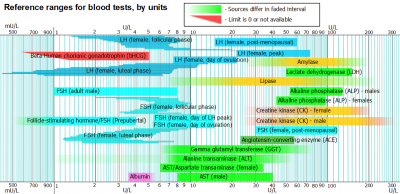4 of the most common blood tests are for haemoglobin, white blood cell count, follicle-stimulating hormone and blood cholesterol. The following two blood tests are usually carried out as part of a Complete Blood Count (CBC).
1. Haemoglobin (Hgb)
Normal ranges:
- Male: 13.5 to 18 gm/dL
- Female: 11.5 to 16.5 gm/dL
(gm/dL: grams per decilitre)
Values may vary dependent upon:
- Age: lower levels in the elderly and children
- Sex: levels decrease during normal pregnancy and menstruation
- Geographic location: high altitudes increases haemoglobin values
- Lifestyle: heavy smokers have higher haemoglobin levels than non-smokers
- Dehydration can temporarily increase haemoglobin levels
- The circadian rhythm: levels peak around 8 a.m. and are lowest around 8 p.m.
The test is used to detect and measure the severity of anaemia, a condition in which
there are too few red blood cells, meaning the body is not getting enough oxygen,
which will result in fatigue and weakness. A high level of haemoglobin is indicative of polycythaemia, which occurs when there are too many red cells in the blood. Severe polycythaemia can cause the blood to thicken, which can lead to heart failure, heart attack or stroke.
This test measures the amount of haemoglobin in red blood cells. Haemoglobin is an iron-rich protein that binds to oxygen, which it carries from the lungs to all parts of the body.
2. White Blood Cell Count (WBC)
Normal ranges:
- 5 – 6.5
Values may vary dependent upon:
- WBC levels may increase during the last trimester of pregnancy.
- Infants usually have higher WBC counts than adults.
- Bacterial infections can increase WBC counts.
- Elderly people may not develop leucocytosis (a high WBC) as a response to infection.
- Removal of the spleen can cause mild to moderate increases in WBC count.
- Medications can cause both higher and lower WBC counts.
- The WBC count tends to be lower in the morning and higher in the late afternoon.
A WBC count might be requested if an immune deficiency, infection, inflammatory illness, bone marrow disease, or allergy is suspected. White blood cells, also known as leukocytes, are made in the bone marrow and protect the body from infection. When an infection develops, white blood cells attack and destroy the microbes causing the infection. A high WBC count is called leucocytosis. This can result from bacterial infections, inflammation, leukaemia, trauma, medication, or stress.
A low WBC count is called leucopenia. It can be due to medications, especially chemotherapy or radiotherapy, vitamin deficiency such as B12 or folic acid, liver disease, an enlarged spleen, or inflammatory conditions such as rheumatoid arthritis, as well as viral infections and diseases of the immune system such as HIV.
3. Follicle-stimulating hormone (FSH)
FSH is often used in conjunction with other hormone related tests:
LH, testosterone, oestradiol, and progesterone.
Normal ranges:
- 5 – 10 UL -1, > 30 UL-1 (post menopausal).
(UL: units per litre)
Values may vary dependent upon:
- FSH levels rise when a woman enters menopause and her ovaries stop working.
- Low levels of FSH are consistent with secondary ovarian failure due to a pituitary or hypothalamic problem, and in the eating disorder anorexia nervosa.
- In men, high FSH levels often occur due to testicular failure, this can happen if the testes are injured or fail to grow properly.
- In young children, high levels of FSH are an indication of early puberty. In delayed puberty, FSH levels can be normal or lower than expected.
- In infants and children, FSH levels rise just after birth and then fall to very low levels (by 6 months in boys and 1-2 years in girls). At about 6-8 years, levels again rise with the beginning of puberty and the development of secondary sexual characteristics.
The FSH test evaluates the function of the pituitary gland, which regulates the hormones that control the reproductive system. It is often prescribed for both men and women experiencing fertility problems, for women experiencing irregular menstrual periods, or where there are symptoms of a pituitary, ovarian, testicular or hypothalamic disorder. FSH may also be used to see if a woman has reached the menopause, or if a boy or girl appears to be entering puberty either too late or too soon.
4. Blood cholesterol
Normal ranges:
- Cholesterol Recommended <5.2 mmol/L (millimols per litre)
- Borderline Risk: 5.2-6.19 mmol/L
- High Risk: > than 6.2 mmol/To screen for risk of developing heart disease
Values may vary dependent upon:
- Low cholesterol can occur where there is an existing condition such as malnutrition, liver disease, stress, or cancer.
- Blood cholesterol is temporarily low during acute illness. You should wait at least 6 weeks after any illness to have cholesterol measured.
- Cholesterol is high during pregnancy. Women should wait at least 6 weeks following delivery to have cholesterol tested.
- Medications known to increase cholesterol levels include: oral corticosteroids, beta blockers, oral contraceptives, thiazide diuretics, oral retinoids and phenytoin.
The blood cholesterol test assesses the risk of developing heart disease (angina, heart attack). The test is requested where patients have a history of heart disease, a family history of high cholesterol or heart disease at a young age, if there are risk factors such as diabetes, high blood pressure, or if the patient is a smoker or obese. The test is also used to monitor patients taking cholesterol-lowering medications. Total cholesterol may be measured alone or in combination with other tests including HDL, LDL, and triglycerides, as part of a complete lipid profile.
Cholesterol comes from your diet and is made in the liver. It forms bile acids that absorb nutrients from food. A diet high in refined cholesterol and saturated fats will increase cholesterol levels. A small portion of the body’s cholesterol circulates in the blood in complex particles called lipoproteins, which carry excess cholesterol away for disposal (HDL, good cholesterol) and some particles that deposit cholesterol in tissues and organs (LDL, bad cholesterol). The blood cholesterol test measures all cholesterol carried in the blood by lipoproteins.
Excess cholesterol in the blood is deposited on the walls of the blood vessels, which
can lead to a build-up of plaque that narrows and eventually blocks the opening of blood vessels, which can lead to hardening of the arteries (atherosclerosis), increasing the risk of heart disease and stroke.
IMAGES: By Mikael Häggström, used with permission.


